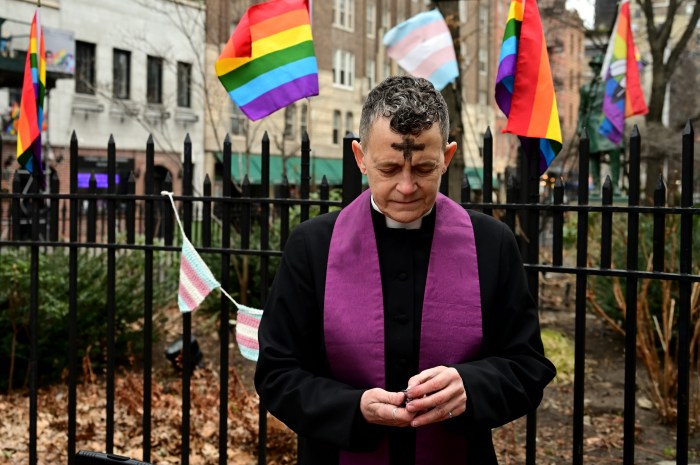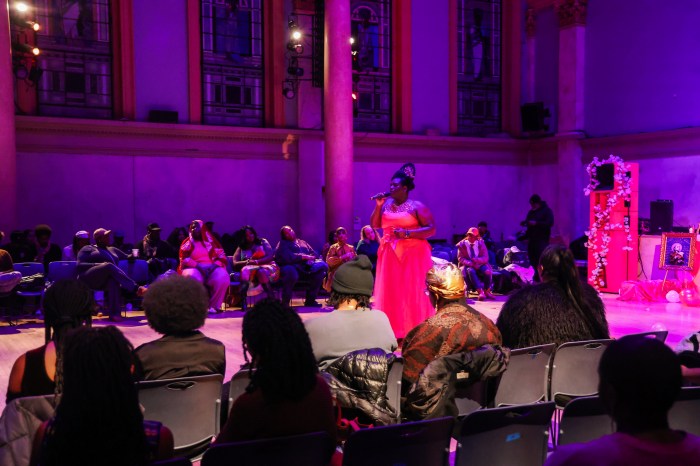The breathtakingly assured, masterfully crafted, and painstakingly detailed paintings of Richard Estes heralded the concept of photo-realism in the art world and remain among the prime examples of this genre. A major retrospective of his New York-inspired work is at the Museum of Arts and Design through September 20, and the opportunity to see the collected output of this extraordinary gay artist is simply one not to be missed.
I met with the artist –– whom I have known casually for years –– in his beautiful apartment in the glorious El Dorado on Central Park West and was once again struck by his miraculous youthfulness, quiet yet intense depth, and utterly refreshing modesty. He said he was happy with the show, but explained, “I haven’t been back since going to the opening. I’m sort of afraid that somebody’s going to recognize me. I should wear sunglasses like Jackie Kennedy, but then I couldn’t see the show. Maybe I could persuade someone to let me look at it when it’s closed.”
Asked how long it takes him to do one of his paintings, which begin with photographs taken by him at various locations and sell for around $400,000, he responded, “A couple of months. I don’t do more than four a year. I work three or four hours a day but then there’s also a half-hour for getting ready, laying everything out and cleaning up stuff. I used to do it twice as long, but I now don’t start until two p.m. I need a lot of sleep, usually about nine hours, plus a nap. I’m really only 50 years old because I’ve slept that much [laughs].”
Master photorealist offers major New York retrospective
Estes, 83, seems to me to be the exact opposite of a flamboyant Julian Schnabel type artist –– low-key, Midwestern, down-to-earth, and sincerely humble to a fault. When I saw him at his MAD opening, the first thing he said to me was, “I want to crawl into a hole.” He added, “‘I was so drunk at my opening. It’s difficult to deal with so many people. So many old friends, and you sort of talk but then somebody else is coming up. It’s sort of awkward. At these openings, it’s impossible to really see the show because there are all these people standing in front of the paintings.”
Estes was born in Kewanee, Illinois, but raised in nearby Sheffield, “a town of a thousand people. My father’s family goes back to the first Irish immigrants in the 1860s. My mother’s parents were both born in Belgium, so I’m half-Flemish, good for a painter [laughs].
“My father had a garage, and my grandfather was a blacksmith. I remember it was like a Velázquez painting: these things would be red hot in the fire and then he’d pound it on the anvil, shape the iron, and plunge it in the water.
“Drawing was always the only thing I knew how to do. When I was about 14, we moved to Chicago, and I went from a class of about 12 students to 1,000. That’s where I got more exposed to art, had never even been to a museum before. I went to the Art Institute of Chicago, where there were a lot of good teachers who had escaped Nazi Germany. I was always into representational/ figurative art. Abstraction was never much of a challenge to me –– with abstract, no matter what, you can’t do a bad painting [laughs].”
After graduating, Estes began to work in advertising, doing “mostly layouts, really sketches for ads for these industrial publications. Also Popular Science and the Reader’s Digest. I started using photographs for my work, like tires skidding on the ice. I preferred to freelance, working at countess little studios, a different job every three months so I could have enough money to live and paint, and not be stuck in a 9-5 job every day.”
Estes made the move to New York in the 1950s but “I never showed my paintings. A friend of mine had just started a small ad agency and I worked for him. I kept using photographs but then thought I’m not going to try to make a fake painting with all this Expressionism, I will just do it the way it is. I think I was sort of influenced by photography because there were photographers at the time doing similar street captures looking through cafe windows and cars. That was in photography, not in painting, so that’s where I began doing it.
“I made a bunch of pictures, mostly of reflections in cars and windows and fenders. They had sort of an abstract quality. They used to sell these Polaroid lenses which could eliminate all the reflections, the opposite of what I was going for. I took a few paintings around to different galleries, and every place I went, they sort of looked at them, and said, ‘This isn’t modern art. What is this?’
“Ivan Karp was working for Leo Castelli and he wanted to take me on, but Castelli said, ‘Oh, no, my other artists wouldn’t approve of this!’ Almost the last place I went to was Allan Stone on 86th Street, before there was a Soho or Chelsea, when the galleries started around 57th Street. Alan was sort of a car collector, and he was intrigued by them and said he’d come over to look at more at my place, which was then on 75th Street between Columbus and Central Park West, in a brownstone for $110 a month.
“My budget was about $300 a month and I could live on it very easily. The subway was 15 cents. So Alan said, ‘Look, we’ll have a show in the spring. I had about six months to do stuff for it, and at my first show, we sold every one. I never went back to advertising again. That was in 1968 [chuckles].”
Asked if he thought he was the first artist to do photo-realism, Estes answered, “I think Chuck Close was doing it but I didn’t know him. Malcolm Morley was doing these boats, and there were a lot of others, too. Duane Hanson was doing very realistic things with figures, a fabulous painter but I don’t think he can work anymore because he has can’t see.”
Surprisingly, the real reason that Estes moved to New York was not for the art, but for the boys.
“It was much easier in New York than Chicago, also just to get away from my family and have my own place. I was living at home, and I had saved enough for six months living expenses to come to New York.
“I was actually pretty old when I had my first experience with a man. I never had any sexual relations until I was about 20, I guess, at the Art Institute. When I made the move from Sheffield, I didn’t make any friends. I was sort of shy in that big school and that’s how I got interested in art and also classical music and opera. There was a wonderful library only a couple of blocks from where we were living and I would borrow records.
“In Chicago, there was a nice park on the lake, and it was very cruisy at night, and every once in a while the police would come in and raid the whole place and everybody would see the lights flashing and run. Once, when I was in art school, I was with my friend and we were walking on Oak Street Beach and this group of guys came and said, ‘You’re faggots!’ and started attacking us. So we ran, but that’s what it was like in those days.
“Even in New York, the bars always had a warning light that would flash. You’d be dancing or doing things in the bar, and everybody would separate and the police would come in.”
Estes has enjoyed a relationship with artist and musician Chris Jones, now his spouse, for 20 years. Prior to that, “I had very strong relationships with a couple of others. José Saenz was from Costa Rica and he died of AIDS in about 1992. I was with him from 1973, and we lived here and he did all the cooking. So many friends died of AIDS, and the other, Jimmy, who was the love of my life, also died of AIDS in about 1987.
“I don’t know how I escaped it, frankly. It’s really weird. I don’t know what they do nowadays –– I’m sort of out of it at this point, but it was pretty wild with the baths and all of that, like in the Ansonia, where Bette Midler got her start.”
Estes, is the very model of that rarest of creatures, a well-adjusted, sane, and functioning artist, who still loves what he does and is performing at full strength even at this stage. “Yeah, I’m an octogenarian, scary! I always considered myself the young person and now I’m the old person. But, my God, I wouldn’t want to go through all my money problems and doing all these things I hated doing in order to survive. I don’t have to do any of that anymore and I haven’t since 1970, for all practical purposes. That’s why I don’t have a studio because, to me, it’s so much better not to have to get dressed and go out and take the subway to go someplace else. I can just be here and do what I want and I’m home. I don’t understand these people who have these studios in some ugly warehouse and they feel they have to do these big paintings.”
Estes also spearheads the Acadia Foundation, which supports the work of painters and is housed in another of his homes, a magnificent 30-room Fred Savage 1893 mansion in Northeast Harbor, Maine, once owned by Helen Roebling Tyson, whose grandfather built the Brooklyn Bridge. “Vincent Longo was there once, and this year we have one artist coming. It sort of started out very ambitious, each summer three artists coming for a month each. But then, less and less [chuckles]. It’s more or less for somebody who can do something with it when I die. It’s all set up.”
Successful as he is, Estes unfairly suffers from a kind of typecasting that goes on in the more-commercial-now-than-ever art world. To me, the most impressive of Estes’ paintings is a jaw-dropping panoramic envisioning of Gaudi’s La Sagrada Familia Cathedral in Barcelona, which is hanging in his apartment. “I can’t sell it. Collectors don’t want figures in my paintings. The one that’s in the show, of Central Park, nobody would buy because of the people in it. The one of Machu Picchu, too. It’s too romantic, they say. So I have to continue to do deserted streets and window reflections.”
RICHARD ESTES | “Painting New York City” | Museum of Arts and Design, 2 Columbus Circle | Through Sep. 20: Tue.-Wed., Sat.-Sun., 10-6 p.m.; Thu.-Fri., 10 a.m.-9 p.m. | $16; $14 for seniors; $12 for students | madmuseum.org






























